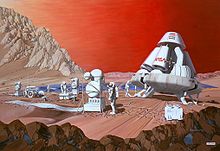Goals

Although some items of the infrastructure requirements above can already be easily produced on Earth and would therefore not be very valuable as trade items (oxygen, water, base metal ores, silicates, etc.), other high value items are more abundant, more easily produced, of higher quality, or can only be produced in space. These would provide (over the long-term) a very high return on the initial investment in space infrastructure.
Some of these high-value trade goods include precious metals, gemstones, power, solar cells, ball bearings, semi-conductors, and pharmaceuticals.
The mining and extraction of metals from a small asteroid the size of 3554 Amun or (6178) 1986 DA, both small near-Earth asteroids, would be 30 times as much metal as humans have mined throughout history. A metal asteroid this size would be worth approximately US$20 trillion at 2001 market prices
Space colonization is seen as a long-term goal of some national space programs. Since the advent of the 21st-century commercialization of space, which saw greater cooperation between NASA and the private sector, several private companies have announced plans toward the colonization of Mars. Among entrepreneurs leading the call for space colonization are Elon Musk, Dennis Tito and Bas Lansdorp.
The main impediments to commercial exploitation of these resources are the very high cost of initial investment, the very long period required for the expected return on those investments (The Eros Project plans a 50-year development), and the fact that the venture has never been carried out before—the high-risk nature of the investment.
Major governments and well-funded corporations have announced plans for new categories of activities: space tourism and hotels, prototype space-based solar-power satellites, heavy-lift boosters and asteroid mining—that create needs and capabilities for humans to be present in space.
Comments
Post a Comment